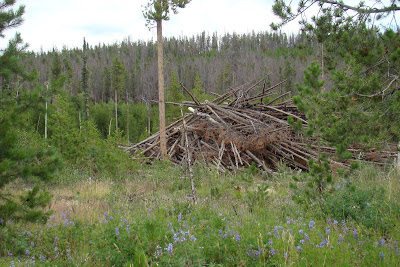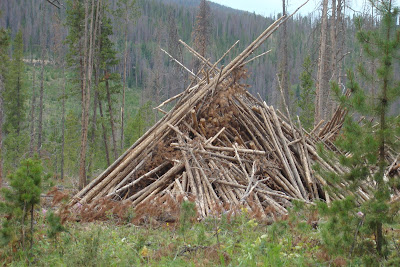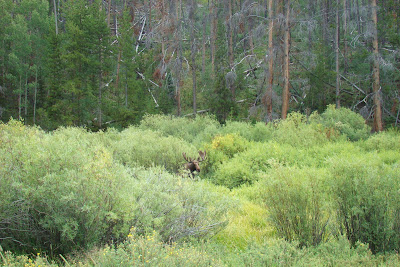 (click on any picture to enlarge them)
(click on any picture to enlarge them)"Mountain pine beetles are chewing through Colorado's high-altitude forests....according to a survey released ... by the U.S. and Colorado forest services.
The beetles spread to 400,000 more acres in 2008, bringing the total area infected to about 2 million acres since 1996, when foresters first began tracking the outbreak."

We dropped off the South Park and picked up I-70 at Frisco, Colorado. Until that point the beetle killed trees had be sporadic. All of a sudden whole forest were predominately brown from dead trees. It had been three years since we had driven this way. The difference in the landscape was stunning.

But as we followed U.S. 40 to Granby it was even worse.

"The mountain pine beetle has left its mark on about 2 million acres of forests in Colorado, primarily targeting lodge pole pines, which grow at between 8,500 and 10,000 feet above sea level. Colorado represents the southern distribution of the (this) beetle infestation which extends north into Canada. "
---Cyberwest (Remember the purple words will lead you to a full article
at another site. Please click on them to see it)

The back side of the tree loss is that the meadow plants have colonized more areas.

"It’s stunning how quickly it all happened. According to the Denver Post, 7.4 million trees on 1.5 million acres were killed between 1996 and 2006.
The big question, and it’s a charged one in a solidly Republican county (58% supported Bush in ‘04), is whether the extent of the damage is due to global warming, or just a part of the natural forest cycle. It’s clear that beetle infestations have happened for ages in Colorado; what’s unclear is whether climate change has pushed this sensitive ecosystem into a tailspin that will only end when all the trees are dead."
----Wired Science
It is not just the Lodge Pole Pine. Spruce and Aspen are now finding their own extinction. "Beetles killed 70,000 acres of spruce trees last year, mostly in southern Colorado's high-altitude forests.
Meanwhile, the mysterious die-off of aspen trees appears to have stabilized, according to a yearly survey of forest health that the Forest Service released Friday.
Forest scientists now believe the aspen die-off was caused by last decade's drought. Aspen decline peaked in 2008 and increased very little last year, according to the annual aerial survey of Colorado forests.
The spruce beetle epidemic, however, is growing with no signs of abatement.
“There's really nothing to stop it," said Susan Gray of the U.S. Forest Service. “The winter temperatures continue to be very mild compared to a decade ago."
The spruce beetle outbreak began in 2002 and has killed 508,000 acres of trees, mostly Englemann spruce, in Colorado and southern Wyoming. Hotspots of the outbreak include Wolf Creek Pass and Colorado Highway 149 between South Fork and Creede. "
After I dropped my wife off in Grandby I continued on to Waldon, Colorado.
The destruction in the Arapaho National Forest was 90% and more.
"Testifying here before the U.S. House Agriculture Committee, Cables said he expects 100,000 trees a day to fall in the national forests in the two states over the next 10 years.
"The trees are falling," Cables said. "We've had several near misses already where falling trees have come close to hurting people."
The forest land closures, he said, may be necessary for the safety of the public and Forest Service employees."
---Trib.com
I pulled off onto a FS rode and drove several miles just wondering at the devastation around me.
The new problem with millions of dead trees.
Trees cut and piled up. When the snow comes, the pile will be burned.
But the willows are still growing along the streams, and the moose are still there. Indeed this makes them easier to find.

"The researchers also noted that the high mortality rate could turn Western forests from carbon sinks, where they absorb the greenhouse gas, into carbon sources, emitting carbon dioxide into the atmosphere as they die — further speeding up the pace of global warming.
"An alarming implication of increased mortality rates is that the fundamental structure of these forests could be undergoing change," Franklin said. "The forests may stabilize at lower overall levels of biomass resulting in less carbon stored in the forests."
The areas studied were 76 forest stands 200 or more years old in Arizona, California, Colorado, New Mexico, Oregon, Washington and Canada's southwestern British Columbia. Researchers counted trees and looked back at records kept for more than 50 years at multiple sites. "
----Culture Change
Will it be over. I heard over and over again in cities like Granby, and Laramie, and Waldon, and Georgetown, that , "they have it under control now". Do they?
"The recent large-scale dieback of piñon (Pinus edulis Engelm.) and ponderosa pine (P. ponderosa Dougl. ex Laws.) and associated bark beetle outbreaks in the Southwestern United States has been linked to the ”climate change type drought” (e.g., dry and warm) that occurred in this region in the early 2000s. Several bark beetle species, including piñon ips (Ips confusus Leconte), Arizona fivespined ips (Ips lecontei Swaine) and the western pine beetle (Dendroctonus brevicomis LeConte), responded to the vast landscapes of drought-stressed trees, contributing significantly to the widespread tree mortality. Because elevated temperatures potentially influence the number of generations of these species reproducing in a single year, similar outbreaks could occur again as precipitation and temperature patterns continue to shift."
Some roads with standing dead timber are close to any type of traffic.

Those brown mountains in the distance are covered in dead trees.
Willow tree wilderness. That's the immediate future in some areas.
The USDA FS signs blithely extol the natural changes the forest is under going.

"Perhaps the most frightening conclusion of the new study is that if current warming trends continue, western forests will move from absorbing carbon and removing greenhouse gases from the atmosphere to emitting more carbon dioxide than they can absorb."
Well, I guess we don't know yet how we shall end. Will it be fire or ice?











2 comments:
One more observation, on the lodgepole pines the beetles only attack older mature trees. Does that mean trees over 6 feet, 8 feet, 10 feet? Does mature mean after or before they can produce pine cones?
Either you will have a giant Christmas tree forest or there is only one more generation of short pines left before oblivion.
I can't resist another observation. What makes the tree lovers believe that with the temperature and moisture change there will be any trees on these mountains. Take a look at the Organ Mts outside Las Cruces N.M..
Even in Oklahoma City, the pine trees here are all dying. Bark beetles, are the culprits. It seem being an econtone area we now have them all here in one place. Whoopee! Actually our pine trees are landscaping trees. They can be replaced with trees that will live. Except for the pine forest in the SE. They are commercial trees. I haven't checked them out yet.
Post a Comment